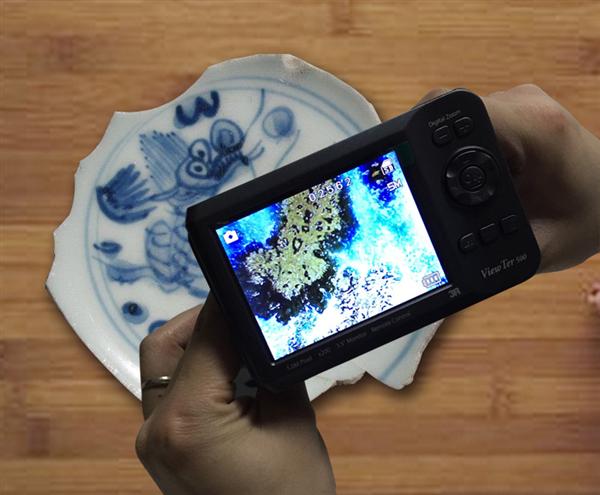Microscopic identification is a method that uses high-powered microscopes to examine the aging process of ceramic glazes, helping to determine the authenticity of ancient porcelain. This technique primarily focuses on identifying bubbles and other microscopic features such as traces, cracks, and erosion. The principle behind this method is that ancient ceramics, after centuries of exposure to soil, water, or air, develop various signs of aging on their glaze. These signs can be observed under a microscope, allowing experts to analyze and authenticate the pieces accurately. The development of microscopic identification has evolved significantly. In the past, only laboratories had access to such technology, making it difficult for the general public to use. However, with technological advancements, portable microscopes are now available in the market. For example, the Ainithi brand offers a portable microscope that can achieve up to 600x magnification, which is sufficient for detailed analysis of ancient ceramics. Traditional methods based on experience and visual inspection are becoming less effective, and new scientific techniques are gaining popularity. As a result, the technical requirements and equipment needed for microscopic identification have become more accessible and reliable. One of the most fascinating aspects of microscopic identification is how it reveals hidden details that are invisible to the naked eye. For instance, when examining celadon glazes under a microscope, you might notice patterns resembling water droplets, turbulent rivers, city streets, or even crystalline formations. These unique features help differentiate genuine items from imitations. Another key point is that while traditional experts may claim they can tell the difference between authentic and fake ceramics just by looking, modern technology shows that even subtle differences can be missed. With a microscope, even novices can distinguish between similar glazes, making the process more objective and accurate. For example, when comparing four seemingly identical kiln fragments, the differences become clear under a microscope. Each fragment displays distinct bubble structures, oxidation levels, and patterns. These variations suggest that even within the same kiln, the manufacturing process, environment, and aging effects can create unique microscopic signatures. This highlights the importance of combining traditional knowledge with modern tools. While experience still plays a role, microscopic techniques provide a more systematic approach to authentication. It's not just about seeing bubbles but understanding the complex history and conditions that shaped the glaze over time. Learning microscopic identification requires a deep understanding of these patterns and their significance. Some researchers have identified specific "identification factors" that are more likely to appear on genuine pieces, such as "cinder bubbles" or "spider web" textures. These features are rare in replicas and serve as strong indicators of authenticity. As technology continues to advance, the future of artifact identification lies in the integration of both traditional and scientific methods. Portable microscopes like the Ainithi models offer practical solutions for collectors and experts alike, making it easier to explore the hidden world of ancient ceramics. Whether you're a seasoned collector or a curious enthusiast, these tools open up new possibilities for discovery and authentication. To make it easier for enthusiasts interested in collecting porcelain, Beijing Aiditek Technology Co., Ltd. has developed a portable microscope specifically for ceramic bubble identification. Currently, free shipping is offered for customers purchasing antique calligraphy and painting items. Cash-on-delivery services are also available upon contacting Ms. Shen. TEL (WeChat) QQ Porcelain appraisal unit designated portable identification microscope brand [Anitty :Anyty ] [Anitty :Anyty ] is the license for the art collection and identification microscope for portable porcelain. The current models include 10-200x, 450-600x, and others designed for different user needs. Classic models like 3R-WM461PCTV are ideal for older collectors, while 3R-MSV500 and 3R-WM461WIFI cater to younger generations. All images shown are schematic representations of the corresponding instruments, mostly provided by collectors.
Cell Phone Holder Ring, Iphone Charging Stand, Mobile Phone Holders Ring, Phone Holder Ring source manufacture in China.
Shenzhen Chengrong Technology Co.ltd is a high-quality enterprise specializing in metal stamping and CNC production for 12 years. The company mainly aims at the R&D, production and sales of Notebook Laptop Stands and Mobile Phone Stands. From the mold design and processing to machining and product surface oxidation, spraying treatment etc ,integration can fully meet the various processing needs of customers. Have a complete and scientific quality management system, strength and product quality are recognized and trusted by the industry, to meet changing economic and social needs .
Phone Holder Ring,Iphone Charging Stand,Mobile Phone Holders Ring,Ring Smartphone Holder Shenzhen ChengRong Technology Co.,Ltd. , https://www.laptopstandsupplier.com [Anitty :Anyty ] 3R-MSV500 Observing the texture of the tile
[Anitty :Anyty ] 3R-MSV500 Observing the texture of the tile [Anitty :Anyty ] 3R-WM401WIFI Observing tile bubbles
[Anitty :Anyty ] 3R-WM401WIFI Observing tile bubbles [Anitty :Anyty ] 3R-WM401PCTV Observing tile bubbles
[Anitty :Anyty ] 3R-WM401PCTV Observing tile bubbles
